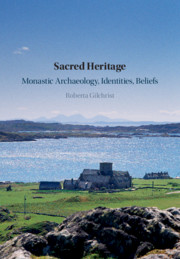Figures
1.2Winchester Cathedral west window, restored shortly after 1660
1.6Coin tree on Isle Maree, Wester Ross (Northwest Highlands) in 2016
1.8The Witness Cairn at the Isle of Whithorn (Dumfries and Galloway) in 2007
2.3Tomb effigy of Lady Dervorgilla at Sweetheart Abbey (Dumfries and Galloway)
2.4Map showing the location of medieval nunneries in Scotland (c.1150–1560)
2.6Book clasp and oil lamp from Elcho Nunnery (Perth and Kinross)
2.7Early monastic settlement at Sgòr nam Ban-Naomha (‘Cliff of the Holy Women’), Canna (Scottish Inner Hebrides)
2.8Map showing culdee and early monastic sites in Scotland (10th–11th centuries)
2.9Map showing monasteries founded by the Canmore dynasty (1058–1286)
2.11Map showing the location of later medieval monasteries in Scotland (1089–1560): Benedictine, Cistercian, Valliscaulian and Carthusian
2.12Map showing the location of later medieval monasteries in Scotland (1089–1560): Augustinian, Premonstratensian, Gilbertine, Trinitarian, Knights Templar and Hospitaller
2.13Map showing the location of medieval friaries in Scotland (c.1230–1560)
2.14Plan showing excavated area of St Ethernan’s Monastery, Isle of May (Fife)
2.15Excavation of burials within the cemetery platform at St Ethernan’s Monastery, Isle of May (Fife)
3.1A hospital ward in the Hotel Dieu, Paris, facsimile after a 16th-century original
3.3Skeletons from St Mary Spital, London, showing evidence for amputation and trephination
3.4Illustration of bone ear-scoop and tweezers excavated from the area of Dunfermline Abbey (Fife)
3.7Small finds from the infirmary hall at St Mary Spital, London
3.8Ceramic urinal from Paisley Abbey’s Great Drain (Renfrewshire)
3.9Bone spectacles from St Mary Merton (Surrey) and Alvastra monastery (Sweden)
3.10Therapeutic devices found in burials at medieval monastic sites
3.11Surgical instruments excavated from Alvastra and Varnham monasteries (Sweden)
3.12Possible surgical hooks from Glenluce Abbey (Dumfries and Galloway)
3.14Illustration of albarello excavated from St Mary Clerkenwell, London, and a similar example in the Louvre Museum
3.15Diagram of distillation equipment and a 16th-century drawing showing similar equipment in use
3.18Pseudo-Apuleius, Herbarius, a mid-13th-century herbal, folio illustrating Gladioli
4.1Jet and glass beads found during excavations of Perth Carmelite Priory
4.2Medieval silver crucifix with large cabochon blue-glass gem and inscribed ‘IHESUS NAZRENUS REX IOUDOREUM’, found near Loch Leven (Perth and Kinross)
4.3Medieval silver finger-ring set with a blue-glass stone and inscribed ‘IESUS NAZA’, found in Gullane (East Lothian)
4.4Silver heart-shaped brooch dating to c.1300, inscribed ‘IHESUS NAZARENUS’, found in Dalswinton (Dumfries and Galloway)
4.5Location of ‘placed deposits’ inside Barhobble Church (Dumfries and Galloway)
4.6Location of ‘placed deposits’ inside the 9th-century church (c.835) at Whithorn (Dumfries and Galloway)
4.7Medieval bronze mortars and iron pestle found buried in Glasgow Cathedral
4.8Photograph showing the location of bronze mortars and iron pestle buried in Glasgow Cathedral
4.9Objects buried in two separate deposits in the church and chapel of Iona Nunnery (Scottish Inner Hebrides)
4.10Objects from St Blane’s Church, Isle of Bute (Argyll and Bute): gold rings, fillets and bar of silver
4.11St Andrews Sarcophagus, St Andrews Cathedral Museum (Fife)
4.12Lead canisters excavated from the chapter house at Melrose Abbey (Scottish Borders)
4.13Wax-like objects found in burials from Perth Carmelite Priory
4.14Lead-alloy cross found around the neck of an individual buried in the East Kirk of St Nicholas, Aberdeen
4.16Lead pilgrim badge decorated with an image of Our Lady of Pity found in the grave of a middle-aged woman buried in the East Kirk of St Nicholas, Aberdeen
4.17Burial of young/middle-aged adult male from St Ethernan’s Monastery, Isle of May (Fife)
4.18Skeleton buried with a scallop shell beside the left leg from East Kirk of St Nicholas, Aberdeen
5.1Cylindrical piers showing zigzag and spiral patterns at Dunfermline Abbey (Fife)
5.2Durable blue glass from Glastonbury Abbey (Somerset) dated to the 12th century
5.4Glastonbury Abbey (Somerset): excavated evidence for a post-Roman timber structure and the location of LRA1 pottery, dated c.450–550 CE
5.5The Lady Chapel at Glastonbury Abbey (Somerset) consecrated 1186
5.6Photograph of Glastonbury Abbey’s Lady Chapel (Somerset) showing elements in the Romanesque style
5.7Lead cross, now lost, allegedly found in ‘Arthur’s grave’ at Glastonbury Abbey (Somerset)
5.9Artist’s reconstruction of the visit of Edward III to King Arthur’s tomb at Glastonbury Abbey (Somerset) in December 1331
5.10Antiquarian illustration of Glastonbury Abbey, Somerset: William Stukeley, 1724 eastern aspect
5.11Devotional objects excavated from Glastonbury Abbey (Somerset)
6.2Photograph of burials taken during excavation of Whithorn Priory (Dumfries and Galloway)
6.3Courtenay Arthur Ralegh Radford at Glastonbury Abbey (Somerset) in 1962 (left)
6.4Plan showing archaeological evidence relating to Radford’s Saxon ‘cloister’
6.9Craftsmen at Iona Abbey (Scottish Inner Hebrides) reconstructing the refectory in 1939
6.10Iona Abbey (Scottish Inner Hebrides) before reconstruction (c.1874)
6.12Glastonbury Abbey’s Lady Chapel (Somerset) c.1900, before restoration
6.17Holy Thorns at Glastonbury (Somerset): St John’s Church and Wearyall Hill
6.183D visualisation of the ‘old church’ at Glastonbury Abbey (Somerset)
6.19Reconstructions of Glastonbury’s ‘old church’ by Spelman (1639) (above) and Bligh Bond (1939)
6.20Artist reconstruction of Glastonbury Lake Village by Amédée Forestier (1911)

